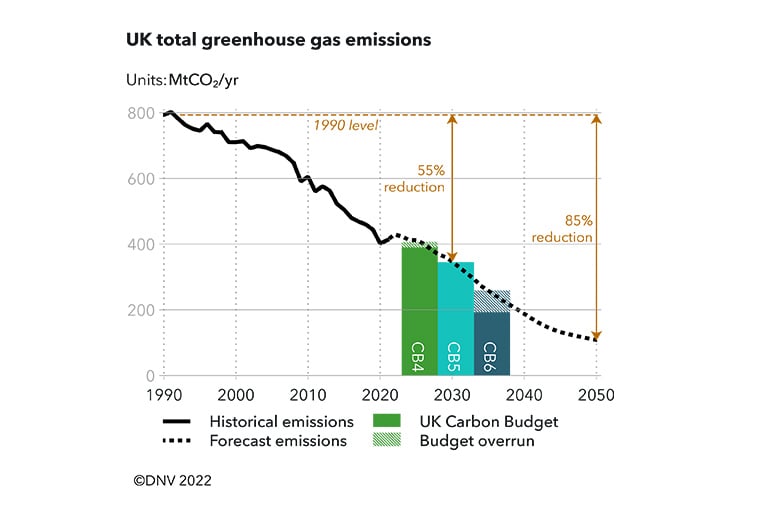Bridges and Bottlenecks to Net Zero
What are the bottlenecks standing in the way of progress and the bridges needed if the UK is to meet its legally binding net zero targets? DNV’s Hari Vamadevan shares his insights.
Over the last few months, our news feeds have been bombarded with troubling alerts of wildfires, floods, and record land and sea temperatures across the globe. We are at the precipice of a significant environmental and ecological disaster.
All a result of man-made climate change. The solution will also be man-made!
However, our efforts to meet net zero targets are becoming more challenging as each day goes by. We must focus the often-polarized discussion on building bridges across energy vectors and de-bottlenecking supply chains and business models.
UK to miss targets
Continuing on the current trajectory, DNV’s latest UK Energy Transition Outlook forecasts that the UK will not meet its legally binding ‘Net Zero by 2050’ target and will fall short of its Nationally Determined Contribution (NDC) commitment for 2030 under the Paris Agreement. The technology exists to bridge the gap from where we are to where we need to be, but several bottlenecks stand in the way of the UK meeting its legally binding net zero targets.

Bridges and Bottlenecks
Today we launch DNV's bridges and bottlenecks campaign, where we dive into the findings of the UK Energy Transition Outlook with companies leading the energy transition. We ask the tough questions on what needs to be done now to effectively tackle and reduce the business risk of climate change. Here’s a snapshot of what our UK ETO has to say:
Renewables bridge to long-term sustainability
The UK’s primary energy supply will shift significantly from fossil fuels to low-carbon sources. By 2050, low-carbon supply sources will dominate and meet nearly 70% of the UK energy needs. Half of that via variable renewables (wind and solar), a third as bioenergy, and the remainder through nuclear. In fact, low carbon resources will overtake fossil fuels in 2041.
The UK energy system and its historical development present challenges to achieving the deep decarbonization required in power generation, transport, industry, and domestic heating. Policy and regulations, cost, skills shortages, permitting and grid connection delays, and supply chain constraints are all impacting the UK’s ability to implement its net zero agenda.
Grids and storage to protect energy equity
In the next three decades, the UK will shift away from fossil fuels, with half of its energy demand delivered by electricity in 2050, and three quarters of that supplied by wind and solar. This change in the UK’s energy mix will require continued power grid expansion and a significant increase in flexibility response to deal with supply variability.
This will require major investment in power generation facilities and associated expansion and strengthening of the UK power grid. Modernization of the grid will involve reinforcement or upgrading of transmission and distribution systems; investments in international interconnections; implementing decentralized energy data and information processes; installing advanced grid features (smart meters, sensors, remote controls); changing processes and business models; establishing more flexible energy markets; undergoing regulatory review; and modernizing system operations.
Interconnectors with other power grids in Europe would provide 20% of the required flexibility — both in terms of exporting excess supply to the continent during times of high VRES generation or supplying back-up power to the UK during supply shortages.
Oil & gas key to energy security
Although in decline, fossil fuel use will continue to be an important energy vector in the short to medium term while the energy transition gets fully underway. In fact, fossil fuels will still cover more than 70% of our necessary energy supply and domestic supplies will be a key factor for security of supply for the UK. There are as many as 20 oil and gas projects in concept or FEED stage and aiming to achieve final investment decision before the end of 2023, thus demonstrating the importance of security of local supply.
Challenges for the fossil fuel industry is varied including skills shortages, the impact of the war in Ukraine, negative public perception, pressure from environmental and social activists, and the impact of global decarbonization efforts. Businesses are also grappling with their own adaption plans with uncertainty of how new energy systems or opportunities to diversify fit with legacy frameworks.
Hydrogen key for hard-to-abate sectors
Renewable (green) and low-carbon (blue) hydrogen are crucial to help the UK meet its commitment to the Paris Agreement goals, particularly in helping to decarbonize hard-to-abate sectors. One key challenge is that producing and converting hydrogen can involve large energy losses. The market and value chains for hydrogen as an energy carrier are in their infancy, even though the potential has been debated for decades. The industry requires clear early policy decisions particularly around the decarbonization of heating in buildings and transport and the government urgently needs to provide leadership and guidance on the role of hydrogen.
DNV Energy Systems on LinkedIn
All energy vectors are needed to ensure the transition to a low carbon future. We need to define the most effective way to decarbonize – achieving the last drops of reduction will take disproportionate investments.
The actions we take now matter.
To hear what energy leaders see as consistent blockers to net zero, and their views on how to balance desired action against the needs of the holistic energy systems and energy trilemma follow #BridgesandBottlenecks on LinkedIn or listen to our new podcast series in conjunction with Energy Voice.
9/11/2023 8:00:00 AM
